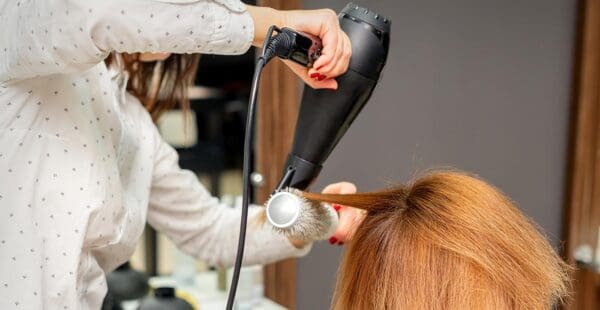01. Asbestos Risk for Hairdressers
How Are Hairdressers Exposed to Asbestos?
Hairdressers and other cosmetology professionals may have been exposed to asbestos components in hair dryers. In the 1970s and early 1980s, commercial and home hair dryers contained asbestos.
Many industrial and consumer products used to contain asbestos. The material was commonly used for its natural heat resistance and chemical durability. As a result, professionals from many industries were exposed to asbestos, a dangerous carcinogen.
Asbestos exposure can cause several serious diseases and cancers. One of the most well-known is mesothelioma, a rare and aggressive cancer.
Hairdressers, barbers and their customers risked asbestos exposure from certain hair dryers. Some barbers may have also used talcum powder on their clients to absorb moisture and reduce irritation. Research shows some talcum powder products have been contaminated with asbestos.
Asbestos in Hair Dryers
In the 1970s and 1980s, the vast majority of hair dryers contained asbestos. According to data from the Occupational Safety and Health Administration (OSHA), 90% of hair dryer manufacturers used asbestos components during this time. They made blow dryers with asbestos to insulate them against high temperatures.
In 1979, the National Institute of Occupational Safety and Health (NIOSH) conducted a study examining the asbestos levels in 30 different hair dryers. The research was conducted on behalf of the U.S. Consumer Product Safety Commission (CPSC).
The study included several types of hair dryers, including:
- Handheld hair dryers
- Heat guns
- Heavy-duty commercial salon-style hair dryers
- Hood-style (bonnet-style) hair dryers
The study confirmed the hair dryers released asbestos levels that exceeded OSHA’s permissible exposure limit. Their findings also showed that the aging asbestos linings in hair dryers created another problem.
No level of asbestos exposure can be considered completely safe. Any level of asbestos exposure may lead to significant health issues, such as asbestosis, lung cancer or peritoneal mesothelioma.
“Mesothelioma can occur from brief exposures and at low doses. There is no evidence of a threshold level of asbestos exposure in which there is no risk of mesothelioma.”
After the NIOSH study was published, most manufacturers voluntarily stopped producing asbestos hair dryers. Today, hair dryers no longer contain asbestos.
Before the 1980s, OSHA data identified 11 major manufacturers who used asbestos in hair dryers and other salon equipment. During this time, these companies generated an estimated 90% of all hair dryer sales each year. As a result, millions of people were potentially exposed to asbestos from hair dryers.
Hairdressers may have been exposed to asbestos in hair dryers made by various manufacturers. The list below contains the specific asbestos-containing models produced by each manufacturer.
Professional and hobbyist hairdressers may have experienced asbestos exposure from their hair dryers. As a result, they may be at risk of developing asbestos-related cancers.
Common Places Asbestos Is Found in the Hairdressing Industry
Hair dryers and heated styling tools were used in many settings. Potential asbestos exposure from these tools is not limited to salons. Some barbers and hairdressers also used talc powder on their clients, which may have been contaminated with asbestos.
Locations that often exposed hairdressers include:
- Beauty product stores
- Cosmetology schools
- Homes, if doing house calls
- Makeup studios
- Salons
Asbestos can become particularly dangerous in poorly ventilated spaces. This allows more fibers to become concentrated in the air. As a result, anyone near an asbestos hair dryer may have been exposed to the mineral.
Hairdressers and At-Risk Trades
Hairdressers are not the only individuals at risk of occupational asbestos exposure as a result of asbestos hair styling products. Other individuals around salons may also have been exposed. This could include other salon professionals or clients.
At-risk trades in the hairdressing industry and similar industries include:
- Barbers
- Cosmetologists
- Estheticians and skin care specialists
- Hairstylists
- Manicurists
- Pedicurists
Secondary asbestos exposure may also occur from the hairdressing and cosmetology industries. Hairdressers and salon workers may accidentally bring home asbestos fibers from their workplace. Airborne fibers may settle on a hairdresser’s clothing, hair, skin or personal belongings. As a result, family members and loved ones may also develop asbestos-related diseases.
02. Mesothelioma Risk for Hairdressers
Mesothelioma Cancer Risk for Hairdressers
Studies have confirmed asbestos levels released by hair dryers are above the permissible limit. OSHA’s permissible exposure limit is only 0.1 fibers/cm3 over an eight-hour, time-weighted average. According to research, asbestos emissions from hair dryers can reach 0.11 structures/cm3.
As a result, hairdressers have an elevated risk of asbestos exposure when compared to the general public. Hairdressers’ occupational exposure can lead to several health issues, including mesothelioma cancer.
03. Compensation for Hairdressers
Compensation for Victims of Occupational Asbestos Exposure
Hairdressers, stylists and barbers with an asbestos-related disease may seek financial compensation. Salon workers and their loved ones may file asbestos lawsuits against companies who produced asbestos products.
For instance, one barber used talcum powder on clients in barbershops he worked in. He later developed mesothelioma after using Clubman products containing contaminated talc supplied by Whittaker, Clark & Daniels. In his personal injury lawsuit, he alleged asbestos-containing talc products caused his disease. After he passed, his family also filed a wrongful death lawsuit.
Hairdressers and their loved ones can contact a mesothelioma lawyer about their best options for compensation. Financial compensation can help mesothelioma patients and loved ones pay for treatment costs and other expenses.
04. Asbestos Safety
Asbestos Safety for Hairdressers
Hazardous consumer products are regulated by the Federal Hazardous Substances Act. These regulations are administered and updated by the Consumer Product Safety Commission (CPSC).
After the NIOSH report in 1979, many hair dryer manufacturers voluntarily stopped asbestos use. To make this standard practice, the CPSC issued a recall for all asbestos-containing hair dryers and salon accessories. These products may still have been in circulation through the early 1980s.
Today, the risk of asbestos exposure for hairdressers is low. Unless decades old, hair dryers are not likely to contain asbestos. However, asbestos diseases have a long latency period. It may take up to 50 years for diseases such as mesothelioma to develop.
As a result, people who used asbestos-containing hair dryers and other tools may continue to be diagnosed with asbestos diseases. Any individual who suspects they may have experienced asbestos exposure should contact a mesothelioma doctor.
Resources for Mesothelioma Patients
05. Common Questions
Common Questions About Hairdressers and Mesothelioma
-
Do hair dryers still contain asbestos?
- Modern hair dryers do not contain asbestos. Around 1980, many hair dryer manufacturers voluntarily stopped using asbestos. However, asbestos-related diseases like mesothelioma often have long latency periods. People exposed to asbestos hair dryers decades ago may still be at risk today.
-
Can asbestos get into your hair?
- Yes, asbestos can get into people’s hair. Asbestos fibers are microscopic and can easily become airborne when people use products containing the mineral. The fibers may stick to clothing and hair. For instance, hair dryers containing asbestos may blow fibers into the air and surrounding areas.
-
How were hairdressers exposed to asbestos?
- Hairdressers in the 1970s and 1980s may have been exposed to asbestos by using hair dryers and other heated salon tools containing the mineral. When hair dryers were used, asbestos fibers could be blown into the air. Anyone nearby was at risk of inhaling or ingesting airborne fibers.




